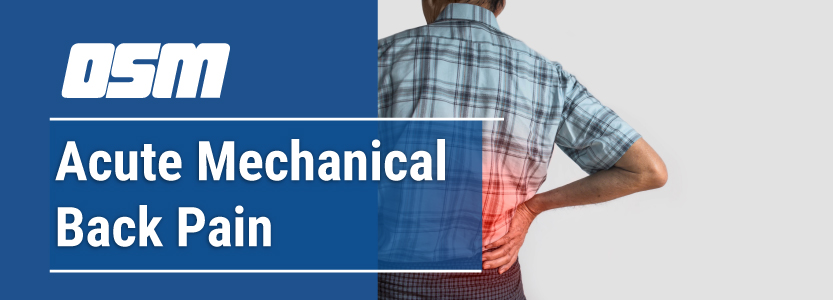Acute Mechanical Back Pain
What is acute mechanical back pain?
What causes mechanical back pain?
A precise cause of your acute mechanical back pain can be identified only 20% of the time. Sometimes, a specific accident or hard activity may cause the pain you’re feeling. However, 80% of the time, the specific source of the pain is not found. Fortunately most people recover in a relatively short period of time with simple treatment.
Mechanical back pain implies the source of pain is in the spine and/or its supporting structure. The surrounding muscles and ligaments may develop reactive spasm and pain.
What are the symptoms of mechanical back pain?
Most people with mechanical back pain experience pain primarily in their lower back. The pain may radiate (spread) to your buttocks and thighs. Many people may also experience spasms with mechanical back pain. The symptoms of mechanical back pain are generally more noticeable with flexion of the back and when lifting heavy objects.
How is back pain diagnosed?
A careful evaluation of your medical history and a physical examination will help your healthcare provider determine if you have mechanical back pain. He or she will then work with you to create an appropriate treatment plan.
If your healthcare provider has determined your back pain is mechanical, additional testing is not usually necessary. If your symptoms or the examination suggest the possibility of infection, malignancy, or a pinched nerve, additional tests may be done. Additional testing may include blood tests, x-rays, computed tomography (CT) scan, magnetic resonance imaging (MRI) and/or nerve conduction studies.
How is back pain treated?
Non-surgical treatment with limited rest and over the counter pain relievers is sufficient treatment for most patients like you. In some people, a supervised physical therapy program for ongoing mechanical pain may be recommended. Talk to your healthcare provider to see which treatment is right for you.
- Bed rest: Short-term bed rest may be recommended for you if you have severe back pain and muscle spasms. Bed rest for more than 48 hours is rarely recommended.
- Physical activity: In some cases, healthcare providers recommend early physical activity to promote rapid recovery from back pain. For moderate to mild back pain, you may be encouraged to maintain a near-normal schedule from the onset.
- Ice and heat application: Applying heat and ice alternately to the lower back is helpful to relax the muscles and decrease muscle inflammation. In general, you are encouraged to apply heat for 20 minutes, and then apply ice for 20 minutes. If you find that one application is more helpful than the other, then use only that application. Generally, heat and/or ice should be applied two to three times per day.
- Medications: If you have muscle spasms, a muscle relaxant may be prescribed for a short time (three to four days). Nonsteroidal anti-inflammatory drugs (NSAIDs) such as ibuprofen or naproxen are available without prescription and may be used to reduce pain. Stronger prescription pain relievers are rarely required.
- Physical therapy: In a few cases, physical therapy may be an essential part of acute back pain rehabilitation. It is important that you work with a physical therapist trained in this exercise approach to promote rapid healing. Active physical therapy can help shorten recovery time and return you to work and leisure activities as quickly as possible. Active physical therapy is an exercise program that may require home exercises as frequently as every two hours while you are awake. The exercises generally take about five minutes to do and do not require special equipment, nor do you need to go to a gym to do them.
What is the outlook for people with back pain?
The prognosis for complete recovery is excellent. Most people with acute mechanical back pain respond very rapidly to treatment. About 90% of people with acute low back pain are symptom-free in one to two weeks. Many of the remaining estimated 10% recover within three months.
Recurrences of back pain are common. Continuing your home exercise program may help reduce your risk of another episode.
When can I return to work?
It’s usually recommend that you return to work right away. If you cannot do your regular job, it is in your best interest to return to some kind of modified duty (light or restricted duty). Your healthcare provider can give you a prescription for a limited period of modified work duty.
It is very common to be afraid to promptly return to work and other activities because of fear of re-injury. However, if you are receiving proper treatment, your risk of re-injury should be limited. It is in your best interest to return to a normal lifestyle promptly. Early mobility has been found to directly result in a more rapid recovery. Maintaining a positive mental attitude is also imperative to a quick recovery.
The Orthopedic & Sports Medicine Center of Oregon is an award-winning, board-certified orthopedic group located in downtown Portland Oregon. We utilize both surgical and nonsurgical means to treat musculoskeletal trauma, spine diseases, foot and ankle conditions, sports injuries, degenerative diseases, infections, tumors and congenital disorders.
Our mission is to return our patients back to pain-free mobility and full strength as quickly and painlessly as possible using both surgical and non-surgical orthopedic procedures.
Our expert physicians provide leading-edge, comprehensive care in the diagnosis and treatment of orthopedic conditions, including total joint replacement and sports medicine. We apply the latest state-of-the-art techniques in order to return our patients to their active lifestyle.
If you’re looking for compassionate, expert orthopedic and podiatric surgeons in Portland Oregon, contact OSM today.
Phone:
Address
17355 Lower Boones Ferry Rd Suite 100A
Lake Oswego, OR 97035
Hours
Monday–Friday
8:00am – 4:30pm



